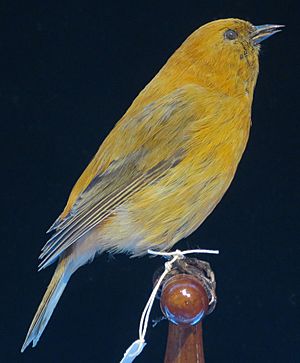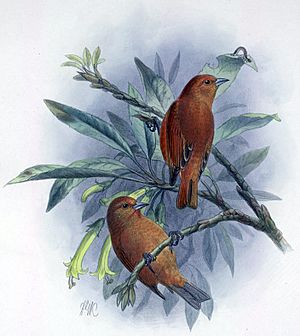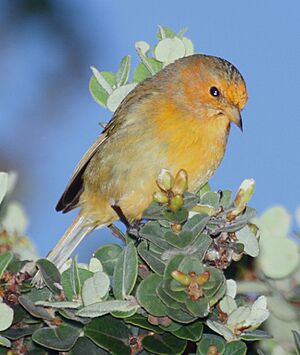Loxops facts for kids
Quick facts for kids Loxops |
|
|---|---|
 |
|
| The Maui ʻakepa, Loxops ochraceus. Specimen shown is a male. | |
| Scientific classification |
|
| Kingdom: | Animalia |
| Phylum: | Chordata |
| Class: | Aves |
| Order: | Passeriformes |
| Family: | Fringillidae |
| Subfamily: | Carduelinae |
| Genus: | Loxops Cabanis, 1847 |
| Type species | |
| Fringilla coccinea Gmelin, 1789
|
|
| Species | |
|
see text |
|
Loxops is a group of small birds from Hawaii. They are a type of Hawaiian honeycreeper. These birds belong to the finch family, Fringillidae. Most of them are commonly known as ʻakepa.
Contents
Types of Loxops Birds
There are five types, or species, of Loxops birds. Sadly, two of these species are now extinct or possibly extinct.
- ʻAkekeʻe or Kauai ʻakepa, Loxops caeruleirostris
- Hawaiʻi ʻakepa, Loxops coccineus
- Hawaiʻi creeper or ʻalawī, Loxops mana
- Maui ʻakepa, Loxops ochraceus - possibly extinct (last seen in 1988)
- Oʻahu ʻakepa, Loxops wolstenholmei - extinct (disappeared in the 1930s)
Scientists have studied the genes of these birds. They found that Loxops mana is the oldest type still alive. It separated from the other species about 1.9 million years ago.
What Loxops Birds Look Like
Loxops birds are small, usually about 11 centimeters (4 inches) long. They weigh around 10 grams, which is about the same as two quarters. They have a notched tail and a cone-shaped bill. Their bills are pale blue with a dark tip.
Male Loxops birds are often bright green on top and yellow underneath. They have a black mask around their eyes. Their forehead and the back of their head are also yellow. Females have similar colors, but they are usually duller and less bright.
The Special Cross-Bill
All ʻakepa birds have a unique bill that crosses over. When their bill is closed, the top part slightly overlaps the bottom part to one side. This is hard to see when the bird is flying.
However, when they open their bill to find food, it swings sideways in a big way. This helps them pry open leaf buds. They use this to find small caterpillars. Some birds' bills cross one way, and some the other. This seems to be random.
Reproduction and Life Cycle
Loxops birds usually breed in March and April. They might also breed from February to June. They build their nests in ʻōhiʻa trees. These trees are very important for their homes.
What Loxops Birds Eat
Loxops birds mostly eat from ʻōhiʻa lehua trees and koa trees. Their special bills are perfect for opening the leaf buds of ʻōhiʻa trees. They search for tiny caterpillars inside these buds.
The flowers (called lehua) of the ʻōhiʻa tree also provide nectar. The birds sometimes drink this sweet liquid. The cracked bark of koa trees is home to many insects and spiders. Loxops birds love to eat these too.
Where Loxops Birds Live
Loxops birds are found only in Hawaii. Each species lived on a different island or part of an island.
- Loxops coccineus (Hawaiʻi ʻakepa): These birds only live in two or three places on the island of Hawaii. One group is in the Hakalau Forest National Wildlife Refuge. Another is in the forests of Kau. A third group might be on the northern side of Hualālai, but they might be gone from there.
- Loxops wolstenholmei (Oahu ʻakepa): These birds were common on Oahu until the 1890s. Then their numbers dropped very quickly. Most people think they disappeared by the 1920s. There were a few unconfirmed sightings in the 1990s. The male of this species was brick red, and the female was dark gray.
- Loxops ochraceus (Maui ʻakepa): This bird lived on the Haleakalā mountain in east Maui. Only a few were seen until 1992, when the last sighting was recorded. It is very unlikely that any of these birds are left, even though some people report seeing green-yellow birds.
Protecting Loxops Birds
Many Loxops species are considered endangered. This means their populations have been shrinking fast. New buildings and human activities are taking away their homes. This reduces the places where Loxops birds can live.
Some areas where Loxops birds live are protected. These include the Alakaʻi Wilderness Preserve and Kokeʻe State Park. These protected areas help keep their habitats safe.



